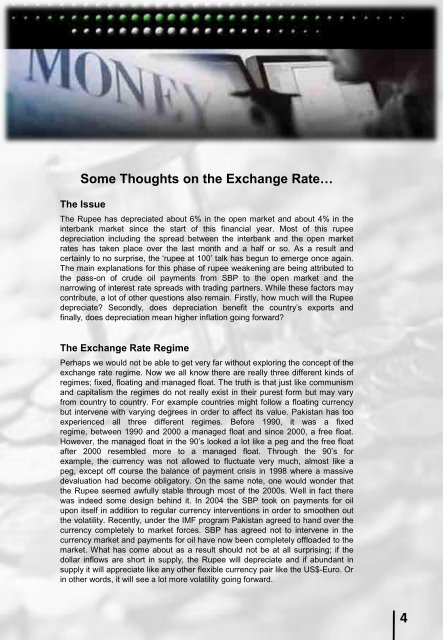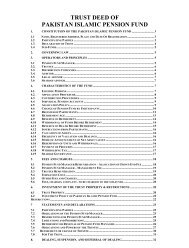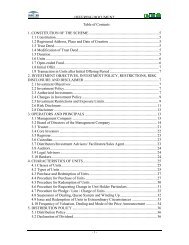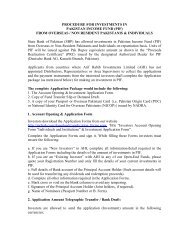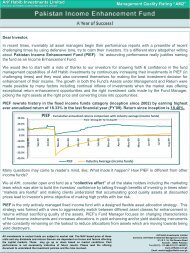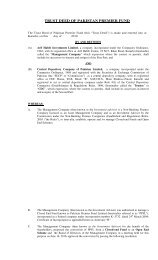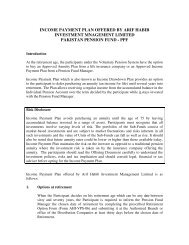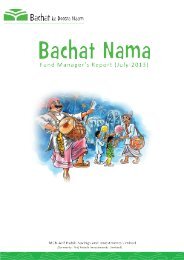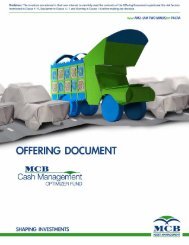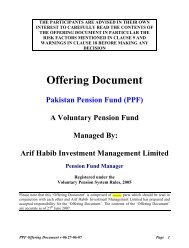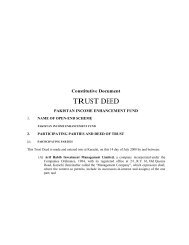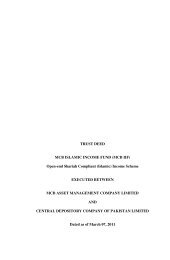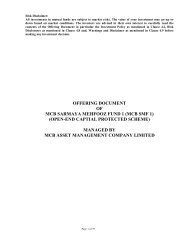January 2010 - MCB-Arif Habib Savings and Investments Limited
January 2010 - MCB-Arif Habib Savings and Investments Limited
January 2010 - MCB-Arif Habib Savings and Investments Limited
- No tags were found...
Create successful ePaper yourself
Turn your PDF publications into a flip-book with our unique Google optimized e-Paper software.
Some Thoughts on the Exchange Rate…The IssueThe Rupee has depreciated about 6% in the open market <strong>and</strong> about 4% in theinterbank market since the start of this financial year. Most of this rupeedepreciation including the spread between the interbank <strong>and</strong> the open marketrates has taken place over the last month <strong>and</strong> a half or so. As a result <strong>and</strong>certainly to no surprise, the „rupee at 100‟ talk has begun to emerge once again.The main explanations for this phase of rupee weakening are being attributed tothe pass-on of crude oil payments from SBP to the open market <strong>and</strong> thenarrowing of interest rate spreads with trading partners. While these factors maycontribute, a lot of other questions also remain. Firstly, how much will the Rupeedepreciate? Secondly, does depreciation benefit the country‟s exports <strong>and</strong>finally, does depreciation mean higher inflation going forward?The Exchange Rate RegimePerhaps we would not be able to get very far without exploring the concept of theexchange rate regime. Now we all know there are really three different kinds ofregimes; fixed, floating <strong>and</strong> managed float. The truth is that just like communism<strong>and</strong> capitalism the regimes do not really exist in their purest form but may varyfrom country to country. For example countries might follow a floating currencybut intervene with varying degrees in order to affect its value. Pakistan has tooexperienced all three different regimes. Before 1990, it was a fixedregime, between 1990 <strong>and</strong> 2000 a managed float <strong>and</strong> since 2000, a free float.However, the managed float in the 90‟s looked a lot like a peg <strong>and</strong> the free floatafter 2000 resembled more to a managed float. Through the 90‟s forexample, the currency was not allowed to fluctuate very much, almost like apeg, except off course the balance of payment crisis in 1998 where a massivedevaluation had become obligatory. On the same note, one would wonder thatthe Rupee seemed awfully stable through most of the 2000s. Well in fact therewas indeed some design behind it. In 2004 the SBP took on payments for oilupon itself in addition to regular currency interventions in order to smoothen outthe volatility. Recently, under the IMF program Pakistan agreed to h<strong>and</strong> over thecurrency completely to market forces. SBP has agreed not to intervene in thecurrency market <strong>and</strong> payments for oil have now been completely offloaded to themarket. What has come about as a result should not be at all surprising; if thedollar inflows are short in supply, the Rupee will depreciate <strong>and</strong> if abundant insupply it will appreciate like any other flexible currency pair like the US$-Euro. Orin other words, it will see a lot more volatility going forward.4


